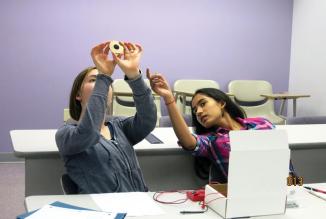SOCK It to 'em
Fall
2013
Interactions - SPS Chapters in Action
SOCK It to 'em
2013 Science Outreach Catalyst Kit (SOCK) Designed by SPS Interns
By:aleb Heath at the University of Arkansas in Fayetteville and Nicole Quist at Oregon State University in Corvallis, 2013 SPS interns
Keep an eye on your SPS e-mails, and you’ll soon see the term “SOCK” in your inbox—as in, “Apply now to get a SOCK for your SPS chapter.” And you should do it. Or make your own SOCK. Let us tell you why.
First, let’s define a SOCK, or Science Outreach Catalyst Kit. It’s a collection of materials and activities designed to be a self-contained outreach experience. That explains the “science,” “outreach,” and “kit,” but what about the “catalyst”? Say you’re a new chapter or new to public outreach, and you want to bring physics to the masses but don’t know where to begin—a SOCK can get you started! Say you’re an older chapter, and your outreach is stuck in a rut—get a SOCK! The SOCK contains demos and activities, and best of all, it’s free—and it comes in a giant sock. (It's not just a cute acronym.) But most importantly, each SOCK is designed around a specific theme, so you can present a focused message during your outreach.
 Each summer, a pair of SPS interns chosen for their interest in outreach and physics education develops a new SOCK. The SOCK team often partners with an external organization. This year we teamed up with the National Institute of Standards and Technology (NIST) in Gaithersburg, MD. We spent 9 weeks designing and testing the lessons and demonstrations in the kit, subjecting it to the scrutiny of a broad sampling of students, from 3rd graders to high school seniors, to make sure there was something for everyone. This year’s SOCK got rave reviews. The 3rd graders loved it. So did dozens of expert middle school science teachers.
Each summer, a pair of SPS interns chosen for their interest in outreach and physics education develops a new SOCK. The SOCK team often partners with an external organization. This year we teamed up with the National Institute of Standards and Technology (NIST) in Gaithersburg, MD. We spent 9 weeks designing and testing the lessons and demonstrations in the kit, subjecting it to the scrutiny of a broad sampling of students, from 3rd graders to high school seniors, to make sure there was something for everyone. This year’s SOCK got rave reviews. The 3rd graders loved it. So did dozens of expert middle school science teachers.
Our partnership with NIST spurred the idea of exploring the theme of sensors and measurement for this kit. Detection and quantification of physical phenomena is what the working scientist does every day, and this year’s SOCK aims to share that experience with students. This is different than previous SOCKs, which have focused more on a specific phenomenon (such as gravity or light).
Several activities are devoted to the details of measurement. Why is it important to put numbers to things? Why do we need standard units, and how do we define them? Length, mass, and time are all explored in the 2013 SOCK.
Each kit also includes an electrical circuit built from off-the-shelf components for hands-on investigations of different kinds of sensors. Modular parts enable you to quickly change out one type of sensor for another. Advanced activities integrate mobile technology apps to explore the mathematics behind the sensors.
If you want a SOCK, be on the lookout for announcements. You’ll have to submit a plan describing how you want to use it and send in feedback detailing your event afterward. Only 25 kits are available. But since the SOCK manuals past and present (including parts lists) are available on the SPS website, you can always make your own. //
More Information
To check out every SOCK created since 2001 and learn more about the program, visit www.spsnational.org/programs/socks/.
